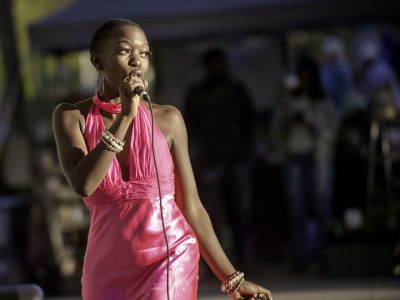Body Games (photo by Ryan Snyder)
by Jordan Green
Ahmed Gallab, a London-born artist of Sudanese heritage with roots in electronic and pop music, defied expectations at last month’s Dance From Above party in Greensboro by turning up with a red-hot live band and making a delightful excursion into early ’70s jam rock in the mode of the Grateful Dead and the Allman Brothers Band, albeit with an African twist.
Celebrating its one-year anniversary, Dance From Above’s June 25 installment at the Crown made a similar frontal assault against the distinction between programmed electronic sounds and live organic sounds.
Body Games, a Chapel Hill trio, did the honors. The group’s newest EP, Local Love Vol. 1, is a sincere tribute to North Carolina bands with conventional guitar-bass-drums-vocals instrumentation that range stylistically from indie-pop and psychedelia to alt-country. With laptop computers, an occasional electrical guitar, keyboards and conventional song structures, Body Games is not far off the beaten track, but you would be advised to not worry about the provenance of the sounds in their arsenal.
Body Games’ set opener, a cover of “Alex Impulse” by the Southport fuzz-pop punk band Museum Mouth, offered up a revelatory example of just how far you can carry the baton. In Body Games’ hands the song was transformed from a careening pop-punk anthem into a melancholic ’80s pop dirge, with saxophone music setting a somber and romantic tone. Kate Thompson and Dax Beaton traded vocals, considerably slowed down from the original and at times processed through a Vocoder.
Half the fun was the light show, which played across double screens, one in front of and the other behind the group. The double screens transformed the stage into a gauzy cocoon, and if it’s possible to imagine three chemists — Adam Graetz is the third member of the group — at work in a lab that doubled as a boudoir, that would be the effect.
Midway through the song, a sampled voice (“When you meet someone special and you want to toss them the key, say, ‘Open up, step inside,’ but you can’t.”) found a complement with letters projected onto the front screen, which dissolved into snowflakes and then coagulated into hearts.
Another song jumped off with a relentless kosmiche — a quick history lesson: the term refers to the German psychedelic offshoot that laid the groundwork for disco — beat and strains of dissonant Velvet-esque guitar, all of which would melt into a droning soup, still retaining fairly conventional vocal structures. The words “more more more” playing across the screen significantly enhanced the experience, with falling Tetris combinations and an old-school video-game format providing an epiphany. “Game over — please try again” is a fitting message from a group that calls itself Body Games.
Not ones to take themselves too seriously or to fully turn their backs on pop song structures, Body Games also dropped a cover of Don Henley’s “The Heart of the Matter,” it’s plaintive cry of “Forgiveness!” cutting through a chaotic scree of noise.” The alchemy of pop shoved into the blender of experimentalism called to mind Sonic Youth’s 1988 cover of Robert Palmer’s “Addicted to Love.”
Despite not being overtly danceable, Body Games elicited a rapturous response from the crowd, with rousing cheers growing more frenetic with each song.
“Thanks for putting up with our slow songs,” Beaton said. “We don’t like to go beyond 88 BPM.”
From high concept during Body Games’ performance, the party moved into shamanistic ritual with Marley Carroll’s DJ set.
Going on about 15 minutes after midnight, the Asheville DJ brought the series full circle, bookending with his appearance at the inaugural Dance From Above a year ago.
Casually taking the boards, Carroll established a deep groove. For the most part the visuals took a backseat to the music, in contrast to Body Games’ nearly seamless integration of the two media. Also less cerebral than Body Games, Carroll’s music created a transfixing dance beat that he and his audience could easily lose themselves in.
Carroll also completely dispensed with the convention of songs that play out in chunks of three to five minutes. His music gradually evolved, almost imperceptibly changing meter and instrumentation, so that a handful of “songs” might fit into a 20-minute stretch, none of them identifiable as discrete entities.
A bass groove from a deep soul cut married with bell tones suggesting Gregorian chants might evolve seamlessly into polyrhythmic percussion or a sound like raindrops on steel drums.
Carroll was like a pacifistic pugilist, leaning into his rig and swaying lightly. The dancers in the audience were similarly lost in the beat — lunging, twirling and sculpting the air with their hands. Like any good musician, Carroll seems to understand that there are places to confound with complexity, and others to pull back so as not to clutter the sonic canvass.
That’s where magic happened: With the beat essentialized and repeated, the dancers became the soloists, improvising off the rhythm track.
Join the First Amendment Society, a membership that goes directly to funding TCB‘s newsroom.
We believe that reporting can save the world.
The TCB First Amendment Society recognizes the vital role of a free, unfettered press with a bundling of local experiences designed to build community, and unique engagements with our newsroom that will help you understand, and shape, local journalism’s critical role in uplifting the people in our cities.
All revenue goes directly into the newsroom as reporters’ salaries and freelance commissions.








Leave a Reply